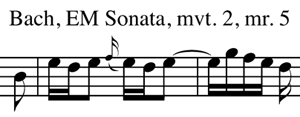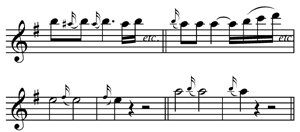“Hello Mr. Debost:
My name is Emily Potter, and I am a flutist from Jefferson, Oregon. After reading your articles in Flute Talk, I wanted to ask you about the proper ornamentation of the Bach Sonata # 1 in B minor, second movement (Largo e dolce). I have listened to several recordings, including those by Michael Faust, Jean-Pierre Rampal, and James Galway, and none of their examples exhibit the ornamentation that I have been told is correct. For example, in the second and fourth measures of the second movement, both Faust and Rampal play the grace note before the beat. I have been taught that in Baroque music it is proper to play the grace note on the beat. Needless to say, I am very confused.”
Emily, you are not the only one! Let us back up a little. Ornamentation in general, and grace notes or appoggiaturas in particular, were not consistently indicated before 1800, because it was assumed that a good musician would implicitly know what to do. In Blavet Sonatas and the Telemann Fantaisies, for example, a trill or ornament was sometimes indicated with a simple + (or not at all). In J.S. Bach’s music, the appoggiatura (leaning) before a cadential trill was written out or implied (or not at all), etc.
It must also be remembered that playing styles differed considerably, because of geographical distance, different generations, instrumental innovations, and so forth. Even the style of J.S. Bach’s sons differed from the towering authority of their father. There was the London Bach, Johann-Christian; the Potsdam Bach, Carl-Philip Emmanuel; and the Halle Bach, Wilhelm Friedemann. What was true for Papa was something else for the kids.
In spite of distance and stylistic idiosyncrasies, there were a few things that “went without saying” but which to us go even better if said. Inevitably, these self-evident truths had exceptions, just like any modern law. If there were no exceptions to laws, our poor lawyers would starve.
The general rule, which in my youth was not really common knowledge, was that a trill always started with the upper note. Take a look at old editions of Baroque music by the old masters. I will accuse no one, cite no names, but there are some very fallacious (and famous) editions that are still sold in flute shops. These editions included ornamentation where none existed in the original (called urtext); dynamic markings and metronomic indications (the metronome dates from ca. 1800); articulations where the original had none or very few; and a general heavy and pompous, let’s say Romantic, approach to music of the 17th and 18th centuries.
However, what was a constant of the Baroque was that the appoggiatura was an expressive tool. It was leaned upon, generating harmonic tension. For that reason, the actual or implicit grace note had more intensity than the actual trill, instead of what we tend to do nowadays, when the shake or trill obliterates everything else.
I spoke about rules (I don’t like the peremptory weight of this word) and now enter the exceptions:
The rule: Grace notes were always long and on the beat, leaned upon as it were (appoggiatura=leaning), except when they were short and before the beat. I am not kidding. Now the four main exceptions:
I. The grace note is long when it is an appoggiatura. An appoggiatura is a non-chord tone that is approached by leap and resolved by step. In the following example, the C natural is an appoggiatura to the B. It receives one-half the value of the B. The B is the third in a G-major chord, progressing to an A in an A M/m7th chord. However, I like to perform the C natural short because all Baroque treatises, the Quantz in particular, set out rules and then qualify them with the admonitions to exercise good taste in whatever you choose to do. That is certainly the case here, whether you select to play the C heavy (long, on the beat) or light (short, before the beat).

II. In bar 2 the grace notes are short, because a grace note placed just before the fastest value of the piece (here 32nds) keeps the flowing value of the shortest notes.

III. The grace note is also short when it is the first note of a larger interval (more than a third). The grace note in bar 10 of the same movement is short, comparable to a kick on a diving board. Here is another example of this springboard idea.

Here the D# grace note is short, a spring to the octave, whereas the A# is a 4-3 suspension, which is played long.
IV. The grace note is short when it is placed on repeated notes.

This tradition is carried over to our Mozart concertos.

There is also a curiosity in Baroque keyboard music called the acciaccatura, meaning crush or squeeze in Italian. Not only was the grace-note short or very short; the two concerned notes were crushed together to create acute dissonance. Such an effect is beyond the possibilities of the flute, but it shows that not all grace-notes were long.
For a long time (1850-1950 approximately), Baroque grace notes were considered a purely decorative, if somewhat dry, embellishment. Then, as the Baroque revival started taking place, ornaments in general and grace-notes in particular became the issue, to the extent that they sometimes appeared to be the tree hiding the forest.
Home > Grace Notes
Grace Notes
SHARE THIS ARTICLE
“Hello Mr. Debost:
My name is Emily Potter, and I am a flutist from Jefferson, Oregon. After reading your articles in Flute Talk, I wanted to ask you about the proper ornamentation of the Bach Sonata # 1 in B minor, second movement (Largo e dolce). I have listened to several recordings, including those by Michael Faust, Jean-Pierre Rampal, and James Galway, and none of their examples exhibit the ornamentation that I have been told is correct. For example, in the second and fourth measures of the second movement, both Faust and Rampal play the grace note before the beat. I have been taught that in Baroque music it is proper to play the grace note on the beat. Needless to say, I am very confused.”
Emily, you are not the only one! Let us back up a little. Ornamentation in general, and grace notes or appoggiaturas in particular, were not consistently indicated before 1800, because it was assumed that a good musician would implicitly know what to do. In Blavet Sonatas and the Telemann Fantaisies, for example, a trill or ornament was sometimes indicated with a simple + (or not at all). In J.S. Bach’s music, the appoggiatura (leaning) before a cadential trill was written out or implied (or not at all), etc.
It must also be remembered that playing styles differed considerably, because of geographical distance, different generations, instrumental innovations, and so forth. Even the style of J.S. Bach’s sons differed from the towering authority of their father. There was the London Bach, Johann-Christian; the Potsdam Bach, Carl-Philip Emmanuel; and the Halle Bach, Wilhelm Friedemann. What was true for Papa was something else for the kids.
In spite of distance and stylistic idiosyncrasies, there were a few things that “went without saying” but which to us go even better if said. Inevitably, these self-evident truths had exceptions, just like any modern law. If there were no exceptions to laws, our poor lawyers would starve.
The general rule, which in my youth was not really common knowledge, was that a trill always started with the upper note. Take a look at old editions of Baroque music by the old masters. I will accuse no one, cite no names, but there are some very fallacious (and famous) editions that are still sold in flute shops. These editions included ornamentation where none existed in the original (called urtext); dynamic markings and metronomic indications (the metronome dates from ca. 1800); articulations where the original had none or very few; and a general heavy and pompous, let’s say Romantic, approach to music of the 17th and 18th centuries.
However, what was a constant of the Baroque was that the appoggiatura was an expressive tool. It was leaned upon, generating harmonic tension. For that reason, the actual or implicit grace note had more intensity than the actual trill, instead of what we tend to do nowadays, when the shake or trill obliterates everything else.
I spoke about rules (I don’t like the peremptory weight of this word) and now enter the exceptions:
The rule: Grace notes were always long and on the beat, leaned upon as it were (appoggiatura=leaning), except when they were short and before the beat. I am not kidding. Now the four main exceptions:
I. The grace note is long when it is an appoggiatura. An appoggiatura is a non-chord tone that is approached by leap and resolved by step. In the following example, the C natural is an appoggiatura to the B. It receives one-half the value of the B. The B is the third in a G-major chord, progressing to an A in an A M/m7th chord. However, I like to perform the C natural short because all Baroque treatises, the Quantz in particular, set out rules and then qualify them with the admonitions to exercise good taste in whatever you choose to do. That is certainly the case here, whether you select to play the C heavy (long, on the beat) or light (short, before the beat).
II. In bar 2 the grace notes are short, because a grace note placed just before the fastest value of the piece (here 32nds) keeps the flowing value of the shortest notes.
III. The grace note is also short when it is the first note of a larger interval (more than a third). The grace note in bar 10 of the same movement is short, comparable to a kick on a diving board. Here is another example of this springboard idea.
Here the D# grace note is short, a spring to the octave, whereas the A# is a 4-3 suspension, which is played long.
IV. The grace note is short when it is placed on repeated notes.
This tradition is carried over to our Mozart concertos.
There is also a curiosity in Baroque keyboard music called the acciaccatura, meaning crush or squeeze in Italian. Not only was the grace-note short or very short; the two concerned notes were crushed together to create acute dissonance. Such an effect is beyond the possibilities of the flute, but it shows that not all grace-notes were long.
For a long time (1850-1950 approximately), Baroque grace notes were considered a purely decorative, if somewhat dry, embellishment. Then, as the Baroque revival started taking place, ornaments in general and grace-notes in particular became the issue, to the extent that they sometimes appeared to be the tree hiding the forest.
ABOUT THE AUTHOR
Michel Debost
Michel Debost is the former principal flutist of the Orchestre de Paris and flute professor at the Paris Conservatory and Oberlin Conservatory. He is the author of The Simple Flute.
MORE FROM THIS ISSUE
Summer Camp Directories
Nothing Happens By Accident A Conversation with Trudy Fraase Wolf
ADVERTISEMENT
Order your Marching and Color Guard Awards this Fall!
Orders may be placed through the online store, by email (awards@theinstrumentalist.com) or by calling 888-446-6888.